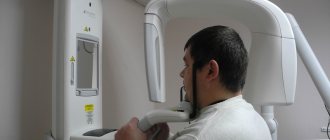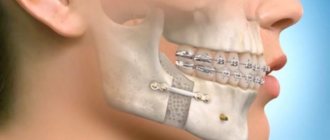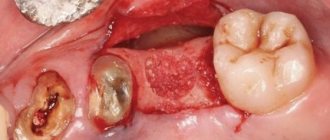Abnormal bite is a common occurrence. With this pathology, there is usually a decrease or increase in the size of one jaw relative to the other, shifts forward or backward, reversals, deviations and displacements to the sides. Teeth do not fit together correctly, become crowded, or have gaps between them. Osteotomy in dentistry - artificial excision of the problematic jaw bone to correct the bite - is a radical and relatively traumatic, but effective approach to eliminating such anomalies.
Consequences of a broken bite
If you leave the problem for many years and do not resort to surgical intervention, there is a high risk of encountering serious orthodontic, gastroenterological and other problems:
- inability to chew food thoroughly, leading to gastrointestinal diseases;
- uneven load on the gums and jaw bones provokes early periodontal disease;
- crowding of teeth does not allow them to be cleaned properly and leads to problems with prosthetics;
- the chewing process is disrupted, causing the temporomandibular joints to suffer;
- Snoring appears, apnea (stopping breathing during sleep) may develop.
A carefully performed operation will eliminate all these troubles and significantly improve the quality of life for people with malpositioned lower and/or upper jaws.
Results of orthognathic surgery
Orthognathic surgery transforms a person, giving him the opportunity to look more beautiful, younger, and do what he loves without being embarrassed by his own appearance. A symmetrical face shape is not only beautiful: maxillofacial anomalies are accompanied by disruption of many body systems, leading to deterioration in breathing, chewing food and diseases of the gastrointestinal tract.
With the help of surgical treatment, it is possible to change the length of the jaw, its position and shape, and improve the condition of the chin. As a result of timely correction, the appearance is transformed, facial features become symmetrical and the overall health of a person improves.
Due to the fact that the surgeon makes all the incisions from the inside, the integrity of the external tissues and the beauty of the facial skin are preserved. Surgical treatment is not accompanied by the appearance of scars and other residual effects. The patient receives maximum aesthetic results and gets rid of malocclusions, which often lead to speech and chewing disorders.
If you suffer from severe malocclusions that cannot be completely corrected with braces or other orthodontic options, you can schedule a consultation with our Clinic's oral and maxillofacial surgeon online or via Skype.
The specialists of the CONSTANTA Clinic in Yaroslavl have many years of experience in the field of plastic and aesthetic surgery. They have at their disposal modern methods of bite correction and safe methods of surgical intervention. Surgeons are focused on the interests of patients and the safest and most effective elimination of anomalies and defects in the structure of the dental system.
Preparing for surgery
Consultation with a plastic surgeon
Before the start of the preparatory period and a comprehensive examination, the doctor must conduct a conversation with the patient in order to warn him about possible risks and contraindications, develop an individual occlusion correction scheme and a surgical intervention plan. The specialist must exclude the presence of diseases that can cause complications both during the operation and in the postoperative period.
Laboratory tests and choice of anesthesia
Before the operation, the patient undergoes a comprehensive examination, which includes laboratory tests. Diagnostic data is carefully studied by the operating surgeon and anesthesiologist, who plan consultations and choose the optimal type of surgery and anesthesia option.
Comfortable postoperative period
From the first minute you contact our specialists, qualified employees who are interested in the successful outcome of the operation will work with you. The rooms are equipped with functional beds and have everything necessary for a comfortable stay. At any time you can call the Clinic’s specialists, get answers to your questions or receive qualified medical assistance.
Personal manager for operation planning
Each patient can use the free Personal Manager service. To do this, you need to call the phone number (4852) 37-00-85 or inform us of your desire to use the service by writing to For out-of-town patients, we offer correspondence consultation via Skype or e-mail.
Indications and contraindications for jaw osteotomy
Corrective osteotomy on one jaw returns it to normal functioning. Surgery on both jaws also improves facial aesthetics.
Indications for its implementation
- improper closure of teeth that is not amenable to orthodontic treatment;
- a clear violation of facial proportions, causing serious discomfort to the person.
Jaw osteotomy should not be performed in the following cases:
- orthopedic or orthodontic treatment has not been completed or not carried out;
- there are any diseases that do not allow a person to be given general anesthesia and guarantee the absence of serious consequences.
The operation should not be performed on people with severe mental disorders or if there is suspicion of malignant cancer.
3D planning of orthognathic surgery
Before
Photo of a face
Photo of a face
Performing an optical scan of the dentition. Optical model of dentition
Performing an optical scan of the dentition. Optical model of dentition
Orientation of the head in space according to the skin
Combining jaw scans with computed tomography
Orientation of the skull in space
3D cephalometric analysis
Stages |
Jaw osteotomies
Moving the Jaws and Creating a Template
Template for operation
Sequence of maxillary osteotomy
The orthodontist is the first to treat any malocclusion. Then - dental surgeons.
- An orthodontist installs braces on the upper and lower jaws to straighten the teeth. For some period of time (~9-10 months), because of this, the teeth stop closing.
- The patient is given general anesthesia. The incision is made from the palatal side (from the inside of the mouth) so that there is no scarring. Cuts are made on the jaws, bone fragments are set in motion and placed so that the shape of the face is most attractive. The new position of the jaws is secured with small titanium plates, which take root well, do not ring metal detectors at the airport, and allow MRI scans to be performed without difficulty. Most often, the plates remain in the body forever and are not felt at all. The muscles, mucous membranes and other tissues are sutured so that there are no disturbances in the nearest nerve branch, an antiseptic bandage is applied to the wound, and the person is taken to the ward to wake up after anesthesia.
How much does it cost to correct an overbite surgically?
The full cost of maxillofacial surgery is indicated at the bottom of the page. It includes:
- consultation with an anesthesiologist;
- orthognathic surgery;
- anesthesia in the operating room;
- stay in the Clinic ward with meals;
- full post-operative observation and care.
You can pay for the transaction in cash, by credit card or by bank transfer.
A patient of our Clinic can receive a tax deduction from the cost of correcting a bite using orthognathic surgery.
Rehabilitation stage
Severe swelling is something all patients should prepare for after an osteotomy. Swelling will persist for up to 3 weeks. Throughout this period, the person walks with rubber bands that prevent the mouth from opening too wide. For nutrition, soft, semi-liquid and warm food with sufficient calories is recommended. Chewing hard foods is prohibited.
After 4 weeks, the patient turns to the orthodontist, who completes the work on the dentition.
Contact only trusted dental clinics; osteotomy is a rather complex type of operation, so it should only be performed by experienced surgeons with good experience.
Orthodontic preparation for surgery and its detailed planning
Orthognathic surgery is designed to achieve a radical effect in harmonizing facial features and giving the smile an aesthetic appearance, so preparation for it is carried out in the most careful manner.
The most important stage of preliminary treatment is wearing orthodontic structures. However, in this case, specially selected braces and arches do not correct the bite, but prepare the dentition in such a way that during the operation, after moving the jaw bones, they form optimally.
Orthodontic preparation usually takes from 3 to 18 months. The duration depends on the severity of the skeletal deformity and the individual response of each patient to therapy.
All orthodontic manipulations are pre-modeled using interactive three-dimensional computer planning programs Nemotec and Dolphin 3D. The programs allow you to visually trace each stage of tooth movement and predict the final result. Computer simulation helps not only to optimize the interaction between the orthodontist and the surgeon, but to demonstrate to the patient extremely inspiring treatment prospects.
Types of jaw osteosynthesis
Osteosynthesis with a metal plate for a jaw fracture is carried out in different ways. It is divided into types according to 2 characteristics - the method of fixing the plates and the technology of the operation itself.
- According to the method of fixing the plate for a jaw fracture, osteosynthesis can be: focal, when the elements of the plate are installed so as to cross the fracture gap and adjoin it;
- extrafocal, in which the plate is fixed outside the jaw fracture gap or passes through it above the mucous membrane and skin (without touching damaged tissues).
- open is carried out with dissection of soft tissues and “opening” of the ends of bone fragments (separation of the periosteum);
The closed method provides accelerated healing, since it does not involve complications that are possible due to impaired microcirculation in soft tissues. But the lack of visual control during closed osteosynthesis of the jaw makes it difficult to properly connect the bone elements and carry out the manipulation in general. This requires a very highly qualified specialist.
The open method of installing plates for jaw fractures (with visualization of the bone) makes it possible to most accurately compare the fragments, as well as remove damaged (interposed) soft tissues or small fragments of hard tissue. The main difficulty of the operation is the risk of tissue hypoxia, which is a common cause of enchondral osteogenesis.
The latter involves the transition of callus to the stage of cartilage, which is not typical for the lower jaw. With enchondral osteogenesis, the formation of a typical (ossified) callus of the lower jaw slows down.
Modern methods also include ultrasonic osteosynthesis with plates . It is carried out using special modern technology and is less traumatic. Installing plates for fractures using ultrasound equipment reduces the likelihood of complications.
Rehabilitation after surgery to correct bite
Rehabilitation is a long, complex stage that will ultimately lead to healthy teeth and a beautiful smile. In the process of recovery after surgery to correct the bite by surgical method, it is important to adhere to the recommendations of doctors: wearing a splint prevents wide opening of the mouth, yawning, blowing the nose, and chewing. It is recommended to temporarily switch to soft foods and eat pureed foods.
The rehabilitation period includes the following stages:
- Use of antibiotics to prevent the development of infection.
- Wearing a rigid bandage for the first few days after the procedure.
- Daily doctor monitoring of changes in the oral cavity.
- After two to three weeks, the dentist removes the sutures.
- After the doctor has noted positive dynamics, in which the processes of healing and bone fusion proceed without complications, the jaw screws are removed (2-4 months after surgery).
During the rehabilitation process, the patient may experience pain and swelling. Although this is a normal reaction of the body to serious and extensive surgery, it is important to report any complaints to your doctor.
How is the procedure done?
The operation to correct the bite is carried out under the supervision of an anesthesiologist, an orthodontist and a maxillofacial surgeon. The surgical procedure is as follows:
- The patient is given general anesthesia.
- The surgeon uses a scalpel to expose the jaw bones.
- Work is underway to move the bones into the planned position.
- The result is fixed using surgical instruments: screws, screws, plates with their further fastening with special rubber bands.
- At the end of the jaw plastic surgery, a rigid splint is placed on the lower half of the face to prevent the bones from mixing.
Depending on the complexity of the case, the operation can take from 1 to several hours.
Plates for jaw fracture
The use of plates after a jaw fracture is justified when a conservative treatment method either does not give the desired result (correct reposition and high-quality fusion of bone parts) or cannot be used initially (complex injury). The decision to perform an operation is made by the doctor after examining the patient (examination if treatment methods other than surgery have already been used).
The advantage of bone osteosynthesis is that when plates are installed to connect fragments, the lesion site is well supplied with blood. This ensures fairly rapid fusion - in just a few weeks - while restoring the bone itself (integrity) and its anatomically correct structure.
When is orthognathic surgery not indicated?
The bite can be changed surgically only when the jaw bones are fully mature - that is, only in adults.
Contraindications to surgery are life-threatening conditions or chronic diseases in the stage of decompensation: cardiovascular, endocrine (diabetes mellitus), oncological (especially tumors in the facial area), as well as disorders in the blood coagulation system, some mental illnesses.
Often patients come to us who have a correct bite and harmonious features, but still require surgery and improvement of existing data. Orthognathic surgery, which has truly transformative properties, works, however, only in the presence of real, and not fictitious, problems, and still has limited capabilities, in some ways superior, but also in some ways inferior to plastic surgery.










